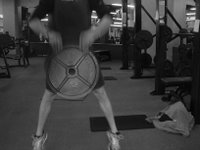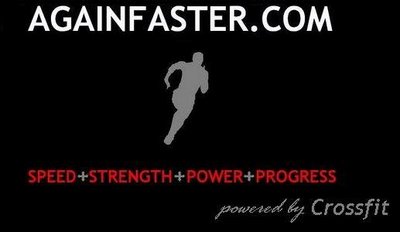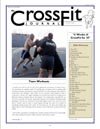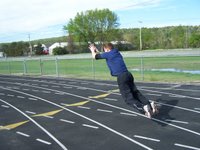Cleaning Faster

The squat clean is complicated. Extension. High pull. Drop under. Catch. Stand up.
It's a lot to deal with.
This morning, Marcia, Jo, Patrick and I put in some much-needed practice. We began with Coach Burgener's warmup, using 8 ounces of PVC to mimic the demands of hundreds of pounds of metal and rubber.
The warmup starts with the snatch grip. The bar lies in the groove of the hips, just above the pubic bone, with the hands as wide as possible. The athlete sinks into the hang position, with the bar resting mid-thigh, the knees bent, and the torso completely vertical.
For the first three repetitions, the arms remain straight as the athlete goes to triple extension, unbending the knees, extending the hips vertically, and shrugging violently.
"One, two, three..."
The next three reps add the high pull to this sequence. The elbows stay above the hands, pulling up and out as the bar comes to chest level.
"Four, five, six..."
Then, the muscle snatch. Triple extension, high pull, and the bar snaps overhead. The snatch is caught in a fully upright position--there is no rebend of the knees, and the bar is eight to twelve inches above the head, elbows locked out.
"Seven, eight, nine."
On to the snatch balance. The bar sits across the shoulders with the feet in the landing position, a few inches outside the hips. The athlete presses down into an overhead squat, hitting the bottom position just as the arms reach full extension. During this movement, the bar shouldn't move. It stays at the same level regardless of the athlete's elevation.


We finished the warmup with the heaving snatch balance. The movement begins with a dip and a drive to triple extension. The athlete then drops under the bar as quickly as possible, landing in a full squat with the arms locked. Again, the athlete should reach the bottom position just as the arms reach full extension. In both the balance and the heaving balance, the athlete stands up with the bar overhead before resuming the start position.
The Burgener Warmup is a great progression through the sub-movements of the snatch, and if you know the snatch, you know the clean. The only difference lies in the width of the grip and the height of the catch. The clean grip is a thumb's width outside the hips, and the bar is caught in the rack position rather than overhead.
Our epic battle with the clean would take us through 20 rounds, each round encompassing 30 seconds of cleaning and 30 seconds of rest. To reinforce the the versatility of the clean, we used three different means of resistance--a barbell, a bumper plate, and a Dynamax ball.

Although we advertised the workout as a clean and jerk sequence, I eliminated the jerk entirely, focusing on the first portion of the lift. We went through 5 rounds on the bar, 5 on the plate, 5 on the ball, and another 5 on the bar.

The plate clean is a unique teaching tool. The shape of the plate eliminates the possibility of a reverse curl, highlighting the need to create weightlessness on an object in order to pull under and execute a successful catch. The athlete learns to temporarily relinquish control of the weight as he/she switches grip from overhand to underhand, eliminating the uncertainty that comes with letting go of hundreds of pounds of resistance when the clean is done with a loaded barbell.



The Dynamax Ball clean requires the athlete to start with a neutral grip rather than a pronated grip. This creates the need to elevate the elbows upward and outward to create room for the pull under, reinforcing the "elbows above hands" dynamic.
While we did the barbell cleans from the hang, the plate and ball cleans were done from the ground.
The clean is a skill. It demands a lot of practice, and its intricacies require constant attention to form. It tends to break down in two principal areas: the rebend and the pull under.

The rebend allows the athlete to orient the torso vertically for the violent second pull. A less-than-vertical torso limits the athlete's ability to transfer power to the bar, limiting momentum and elevation, and increasing the depth required for a successful catch.
The pull under must be lightning-fast. The need for speed requires a lack of fear from the athlete. As the weight on the bar increases, the athlete must maintain confidence in his/her ability to catch the bar. Unfortunately, we're wired for self-preservation, and convincing our minds that our bodies are capable of catching hundreds of pounds in a full-squat can be difficult. Constant repetition creates confidence.
Marcia and Jo did an admirable job for all twenty rounds, switching between implements seamlessly. While they worked, Patrick and I spent some time working the sub-movements of the clean--the starting position, the first pull, the second pull, and the front squat.
Everyone did a great job. I appreciate the commitment to excellence. As we know, mechanics come before mastery, and the willingness to struggle through difficulty is the mark of progress.
Next week we'll be back at the Pond, rain or shine, continuing our pursuit of Crossfit excellence. If you're in the area, stop by. We'd love to have you.
Go faster!
 Check out Again Faster tomorrow afternoon for coverage of our recent rock climbing trip to upstate New York. We had a great time refining balance, flexibility, and strength on the cliffs of the Shawangunk Mountains.
Check out Again Faster tomorrow afternoon for coverage of our recent rock climbing trip to upstate New York. We had a great time refining balance, flexibility, and strength on the cliffs of the Shawangunk Mountains.

The squat clean is complicated. Extension. High pull. Drop under. Catch. Stand up.
It's a lot to deal with.
This morning, Marcia, Jo, Patrick and I put in some much-needed practice. We began with Coach Burgener's warmup, using 8 ounces of PVC to mimic the demands of hundreds of pounds of metal and rubber.
The warmup starts with the snatch grip. The bar lies in the groove of the hips, just above the pubic bone, with the hands as wide as possible. The athlete sinks into the hang position, with the bar resting mid-thigh, the knees bent, and the torso completely vertical.
For the first three repetitions, the arms remain straight as the athlete goes to triple extension, unbending the knees, extending the hips vertically, and shrugging violently.
"One, two, three..."
The next three reps add the high pull to this sequence. The elbows stay above the hands, pulling up and out as the bar comes to chest level.
"Four, five, six..."
Then, the muscle snatch. Triple extension, high pull, and the bar snaps overhead. The snatch is caught in a fully upright position--there is no rebend of the knees, and the bar is eight to twelve inches above the head, elbows locked out.
"Seven, eight, nine."
On to the snatch balance. The bar sits across the shoulders with the feet in the landing position, a few inches outside the hips. The athlete presses down into an overhead squat, hitting the bottom position just as the arms reach full extension. During this movement, the bar shouldn't move. It stays at the same level regardless of the athlete's elevation.


We finished the warmup with the heaving snatch balance. The movement begins with a dip and a drive to triple extension. The athlete then drops under the bar as quickly as possible, landing in a full squat with the arms locked. Again, the athlete should reach the bottom position just as the arms reach full extension. In both the balance and the heaving balance, the athlete stands up with the bar overhead before resuming the start position.
The Burgener Warmup is a great progression through the sub-movements of the snatch, and if you know the snatch, you know the clean. The only difference lies in the width of the grip and the height of the catch. The clean grip is a thumb's width outside the hips, and the bar is caught in the rack position rather than overhead.
Our epic battle with the clean would take us through 20 rounds, each round encompassing 30 seconds of cleaning and 30 seconds of rest. To reinforce the the versatility of the clean, we used three different means of resistance--a barbell, a bumper plate, and a Dynamax ball.

Although we advertised the workout as a clean and jerk sequence, I eliminated the jerk entirely, focusing on the first portion of the lift. We went through 5 rounds on the bar, 5 on the plate, 5 on the ball, and another 5 on the bar.

The plate clean is a unique teaching tool. The shape of the plate eliminates the possibility of a reverse curl, highlighting the need to create weightlessness on an object in order to pull under and execute a successful catch. The athlete learns to temporarily relinquish control of the weight as he/she switches grip from overhand to underhand, eliminating the uncertainty that comes with letting go of hundreds of pounds of resistance when the clean is done with a loaded barbell.



The Dynamax Ball clean requires the athlete to start with a neutral grip rather than a pronated grip. This creates the need to elevate the elbows upward and outward to create room for the pull under, reinforcing the "elbows above hands" dynamic.
While we did the barbell cleans from the hang, the plate and ball cleans were done from the ground.
The clean is a skill. It demands a lot of practice, and its intricacies require constant attention to form. It tends to break down in two principal areas: the rebend and the pull under.

The rebend allows the athlete to orient the torso vertically for the violent second pull. A less-than-vertical torso limits the athlete's ability to transfer power to the bar, limiting momentum and elevation, and increasing the depth required for a successful catch.
The pull under must be lightning-fast. The need for speed requires a lack of fear from the athlete. As the weight on the bar increases, the athlete must maintain confidence in his/her ability to catch the bar. Unfortunately, we're wired for self-preservation, and convincing our minds that our bodies are capable of catching hundreds of pounds in a full-squat can be difficult. Constant repetition creates confidence.
Marcia and Jo did an admirable job for all twenty rounds, switching between implements seamlessly. While they worked, Patrick and I spent some time working the sub-movements of the clean--the starting position, the first pull, the second pull, and the front squat.
Everyone did a great job. I appreciate the commitment to excellence. As we know, mechanics come before mastery, and the willingness to struggle through difficulty is the mark of progress.
Next week we'll be back at the Pond, rain or shine, continuing our pursuit of Crossfit excellence. If you're in the area, stop by. We'd love to have you.
Go faster!
 Check out Again Faster tomorrow afternoon for coverage of our recent rock climbing trip to upstate New York. We had a great time refining balance, flexibility, and strength on the cliffs of the Shawangunk Mountains.
Check out Again Faster tomorrow afternoon for coverage of our recent rock climbing trip to upstate New York. We had a great time refining balance, flexibility, and strength on the cliffs of the Shawangunk Mountains.




















3 Comments:
Thanks for another good workout, as well as the form pointers! For those that weren't there, you missed a very focused and specific workout; as well as Jon going ballistic on Marcia for answering her phone mid set. High comedy indeed.
Jo
I'm glad you could make it, Jo. Your squat clean looks great. And Marcia...Marcia deserved everything she got. Who the hell answers a cell phone in the middle of a workout? ;)
We'll see you next week, Tara. I had a great time flipping the loader tire with you guys on Saturday.
Hey Jon, sorry I missed this one but your post is still a great lesson. Hope to see you in a couple of weeks and congrats on your affiliation.
Post a Comment
<< Home